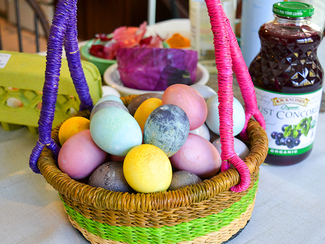
Get a L'Egg Up: Natural Egg Dyeing
The season of Spring is usually associated with rebirth and renewal, and what could be a more fitting symbol of birth and renewal than a simple egg? This is one the reasons why eggs are so closely linked to the holiday of Easter, and why dyeing eggs is a favorite pastime this time of year. My son and I love dyeing Easter eggs together each year. For a long time I used to think eggs only could be dyed with those strange chemicals–but boy, was I ever wrong! Apparently, this whole time I could have been dying eggs with leftover items from my kitchen. Who knew?
A word of warning: natural Easter egg dyeing is a lot of work.
Naturally dyed eggs are as charming as they are difficult. I will admit, they can be messy and time consuming, but that's part of the fun. It's also a great way to avoid the chemicals that have seeped into almost every part of our daily lives. I love teaching my son that everything we need can be found in nature, and that we don’t have to be reliant on man-made products to do the projects we like to do.
Here's what you can expect on dye day: a stovetop crowded with pots cooking the materials for various dye baths; a pot for every hue (I highly recommend getting take-out due lack of space and cookware); mason jars littering the counter–just one splash away from staining your countertops; and a pastel-colored egg army overtaking your fridge. Some eggs must soak for as long as eight hours to achieve that perfect color, and sometimes, despite your best efforts, experiments with pigmentation will end up dyeing many of your eggs brown. It's not for the faint of heart.
It's the end product that makes all of that hard work worth it. Expect a rich nuance that can only be found with a naturally dyed egg, where each one will be slightly different, yet perfect in its own way.
The process for creating naturally dyed Easter eggs looks something like this: Up to three weeks ahead, I start putting kitchen scraps aside just for this purpose: onion peels, spices, leftover cooking water...no item is exempt from experimentation, with items being culled and put away for later use. Once I have the perfect assortment of materials to get started dyeing eggs, I create my dye baths. This is when I toss my selected items in a pot and boil them. I later combine the dye bath with a bit of vinegar in a mason jar, give my eggs a little dip, and behold...the naturally colored Easter egg.
Gorgeous.
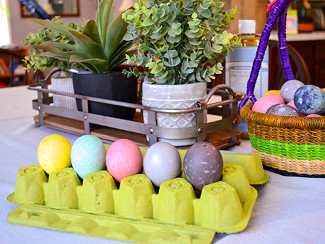
What You Are Going To Need
To get the right results you need the right materials. The materials I used were:
- Eggs, hard boiled (I like Appleridge Farm eggs, for their varied colors)
- White vinegar (One tablespoon per cup of dye created.)
- Mason jars (I prefer half pint ones, and did one egg per jar to minimize markings on the eggs.)
- Pots (one for each dye bath, or be prepared to wait while each dye bath is cooking)
- Fine mesh strainer
- Egg dryer (I used an upside down egg carton)
- Castile soap
- Plenty of fresh water
- Paintbrush (optional)
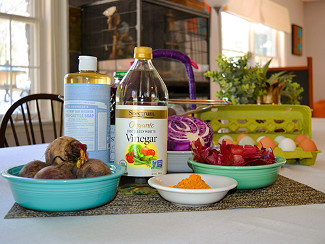
The plant materials I used to create the dye baths were:
- Grape juice
- Turmeric
- Beets
- Red onion skins
- Red Cabbage
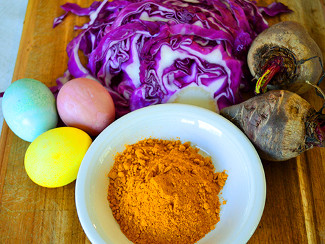
The Directions
- Hard boil the eggs. I’m sure you know how to do this already, but lets review anyway: gently lower eggs in a pot large enough to fit them all, and cover by at least one inch with some water. Turn the heat on high and keep it going until it starts to bubble. Let it go for at least ten minutes, and then turn it off and let it cool. You can gently replace hot water with cold to let the eggs cool faster.
- Once cooled, wash the eggs with Castile soap (I like Dr. Bronner’s). Give them a good rub-a-dub-dub to remove any residue that could prevent the dye from adhering. I gave mine a rub with a dish rag, but you can use your thumb also. Congratulations: your eggs are now ready to be dyed.
- Prepare your dye bath. This is where wild variance will come into play, as each dye bath will be different according to your desired result. Think of this as a guide, rather than hard and firm rules.
- First, bring desired amount of water to a boil. The general rule is one cup water for each handful of organic matter, or 1 tablespoon powdered matter (like turmeric) per cup.
- Prepare any raw materials. Beet should be grated, and cabbage can be chopped.
- Boil the materials until they reach the saturation you want, usually about fifteen minutes worked well for me, but you can go longer if you’d like.
- Your dye material is now ready to be strained, but wait–not so fast! Take this moment to add 1 tablespoon of vinegar per cup of liquid that you will put in your mason jars. I did one cup of water per mason jar.
- Place in sink and place fine mesh strainer firmly over your mason jar. Now pour your dye bath in, leaving at least an inch of room between the water and top of the jar per egg that you will be placing in the jar. CAUTION: VERY HOT, USE CARE WHILE DOING THIS. Now, whisk vinegar/dye solution to disperse. Decide if you want to dye your eggs with a hot bath or cool bath. A hot bath will make the colors more saturated, while a cool one will keep them soft and pastel. Let water cool if you want a cool bath. If you decide to let them sit in the bath for more than a few minutes, you can place in the fridge now.
- Beets: I used a cup of beets with a little over a cup of water (enough to cover the beets). I boiled them for fifteen minutes, and I achieved the best results with a cold bath and a quick dip.
- Grape juice: Boil the grape juice. I used a hot bath. A five minute dip gets you a lovely shade of lavender. A fifteen-minute soak gets you a deeper blue. Overnight soaking gets you a beautiful, but mottled purple.
- Turmeric: I added one tablespoon turmeric to one cup water, in a hot bath. A five minute soak gets you a soft, but pure yellow. A fifteen minute soak deepens the color and gets you hints of gold. Be sure to whisk the turmeric first before adding the eggs!
- Red cabbage: These eggs must be soaked around eight hours before you see results. Chop about one cup cabbage for a little over a cup of water. Start with a hot bath, and soak overnight. The wait is worth it for it’s perfect robin’s egg blue hue.
- Red onion skins: I did not have much success with these as they made my eggs cocoa-brown–not exactly the result I was expecting. If you want to try, I used a handful of onion skins for a cup of water, boiled them for thirty minutes, and then soaked the eggs in it for five minutes. A hot bath was used.
- Now, dry your eggs. For this, I used an upside down egg carton and let them sit. After five minutes I flipped the eggs and blended any color that pooled at the bottom with a paintbrush. That was it.
Tip: You can also check on them immediately after dipping in the bath and decide based on that how long they should stay.
I took the following steps for each color and here were my results:
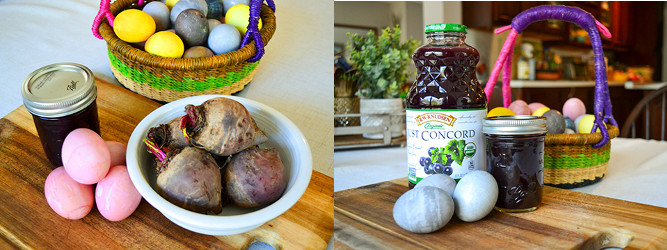
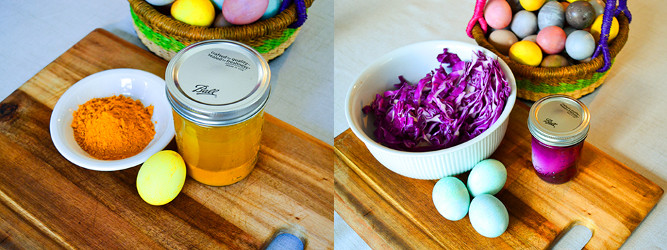
Note: These eggs are still edible, and if you want to enjoy the fruits of your labor make sure you place them in the fridge for any step that requires waiting.
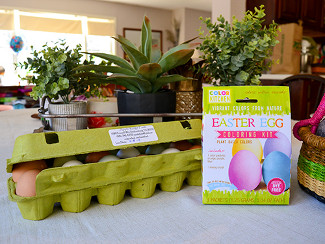
Dyeing your eggs is a wonderful family activity and naturally produces a beautiful egg you don't see with dye kits. However, if you are short on time, or just can’t be bothered, I also have had success with this dye kit: Color Kitchen Natural Easter egg coloring kit. This kit is gluten-free, vegan-friendly, and uses natural plant-based dyes,
Now...hop to it, have fun, happy dyeing, and, also, try not to break an egg–haha, get it?